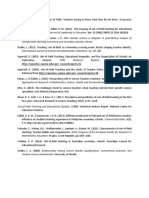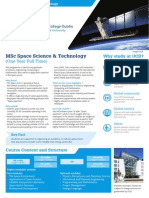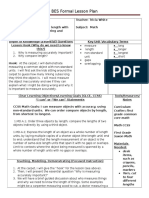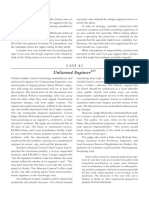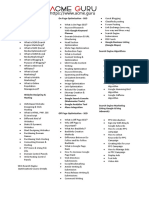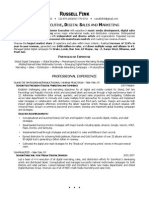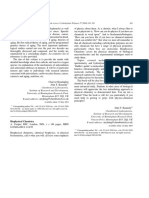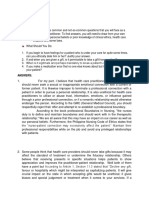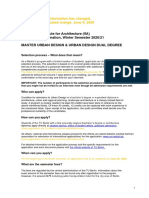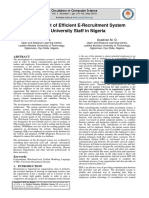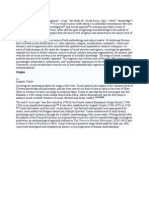Professional Documents
Culture Documents
Resume Refinement System Using Semantic Analysis
Original Title
Copyright
Available Formats
Share this document
Did you find this document useful?
Is this content inappropriate?
Report this DocumentCopyright:
Available Formats
Resume Refinement System Using Semantic Analysis
Copyright:
Available Formats
Volume 3, Issue 3, March– 2018 International Journal of Innovative Science and Research Technology
ISSN No:-2456-2165
Resume Refinement System using Semantic Analysis
Ruchita Haresh Makwana Aishwarya Mohan Medhekar Bhavika Vishanji Mrug
IT Department, IT Department, IT Department,
K J Somaiya Institute of Engineering K J Somaiya Institute of Engineering K J Somaiya Institute of Engineering
& IT, Sion, & IT, Sion, & IT, Sion,
Mumbai, India. Mumbai, India. Mumbai, India.
Abstract:- The Resume Refinement System focuses on The scope of our online recruitment system: The
online recruitment process, where the recruiter uses this Resume Refinement System will help the recruiter to find the
system to hire the suitable candidate. Recruiter post the appropriate candidate for the job post. It is the time saving
job-post, where the candidates upload their resumes and process for the recruitment. Since previously all this process
based on semantic analysis the web application will was done manually the chances of right candidate was
provide the list of shortlisted candidates to the recruiters. minimum. By using this system the chances of selecting right
Since web documents have different formats and contents; candidate is maximum. Besides using programming languages
it is necessary for various documents to use standards to to select candidate, we are going to use educational
normalize their modeling in order to facilitate retrieval background, years of experience etc. The scope of this project
task. The model must take into consideration, both the is to get right candidate for the job post, with minimum time
syntactic structure, and the semantic content of the requirement and to get efficient results.
documents. Resume is the document that summaries our
education, skills, accomplishments, and experience. Job II. LITERATURE SURVEY
seekers submit their Resume via the web. Therefore, in
their recruitment process, companies are requiring
systems for extraction and analysis of information from A. An Automatic Online Recruitment System Based on
Resume: identifying specific patterns, which meet with Exploiting Multiple Semantic Resources and Concept-
certain profile. To extract the essential component of Relatedness Measures.
Resumes and to relate them with recruiter's requirements
needs first, a study of their most significant elements and a Recruitment is considered among the most
better understanding of the resume feature. This work challenging functions for job portals and human resource (HR)
focuses on resume analysis. departments. This is because employers often receive a huge
number of resumes – some of which are uploaded as
Keywords:-Online recruitment, semantic analysis, neural unstructured documents in different formats such as .pdf, doc,
network, missing background knowledge. and .rtf, while others are uploaded according to specific forms
prepared by employers – that are difficult to manually process
I. INTRODUCTION and analyze. Recently, many companies have shifted to
Few years back recruitment process was done automatic online recruitment systems in an attempt to reduce
manually. HR posts the job requirements on a particular site the cost, time, and efforts required for screening out applicants
where candidates upload their resumes. Then the HR will and matching candidate resumes to their relevant job posts.
download the resumes and will do the keyword matching Several techniques/approaches have been employed by online
manually ignoring the semantics of the job post and the recruitment systems. Examples of these techniques are
resume contents due to which large number of gained results Boolean Retrieval, models based on Relevance Feedback ,
are irrelevant. To overcome this we have proposed this system Analytic Hierarchy Process, Semantics- based techniques, and
where it will do semantic analysis and will give appropriate Natural Language Processing (NLP) and Machine learning
results. based approaches. Although these techniques achieve good
matching results, they are still limited by the obstacles.
An online recruitment system that first employs
Natural Language Processing (NLP) tools to find and extract a In order to avoid the obstacles they have proposed an
list of candidate concepts from both job posts and candidates automatic online recruitment system that exploits multiple
resumes. Next, existing semantic resources (also referred to as semantic resources in an attempt to highlight and capture the
ontologies) are cooperatively incorporated to analyze the list semantic aspects of both job posts and candidate resumes. The
of candidate concepts at the semantics level. When a concept proposed system employs NLP pre-processing techniques to
is not recognized by the used semantic resources, statistical- identify and extract lists of candidate concepts from job posts
based concept-relatedness techniques are then used to address and resumes. In addition, it utilizes statistical concept-
this issue. relatedness measures (extracted from Hiring solved Dataset) to
enrich and expand the lists of candidate concepts with entities
IJISRT18MA192 www.ijisrt.com 193
Volume 3, Issue 3, March– 2018 International Journal of Innovative Science and Research Technology
ISSN No:-2456-2165
i.e. concepts that were not initially recognized by the B. Proposed System
employed semantic resources.
Here we will create a web-application where resumes
B. Matching Sem Online recruitment system based on multiple and job post is given as a input to the system. Since web
semantic resources documents have different formats and contents it is necessary
to preprocess in order to facilitate retrieval task. To do so we
They have proposed an online recruitment system use NLP pre-processing Techniques which are as follows.
where they use a combination of multiple semantic resources First we will convert the resumes into a particular format i.e
and statistical based techniques. The aim behind using txt format. Then we will perform tokenization like sentence
multiple semantic resources is that they are capable of tokenization and word tokenization. Next we will remove the
representing several domains and derive the semantic aspects stop words like ‘the’ , ‘an’ , ‘a’ etc. Then we will do tf-idf,
of resumes and job posts. When some of the identified speech tagging, named entity recognition. Next we will create
concepts (from the resumes of job posts) are not found in the semantic networks of job post and resumes by using Word net,
employed semantic resources, then, the statistical-based Dbpedia ontologies and the algorithm used will be Jaro
semantic relatedness measures are used in an attempt to find distance for finding the similarity between both the networks.
the relation between those missing concepts i.e. from the Finally recruiter will get the resumes of suitable candidates.
semantic resources and those that are defined in them.
C. Toward the Next Generation of Recruitment Tools: An
Online Social Network-based Job Recommender System
The rapid growth of social networks in recent years
has developed a new business: the trade of social networks
users data. These social networks data are becoming important
for many companies around the world and are often used to
determine social networks users interests for items in order to
propose or advertise items to them. Recommender systems
help users deal with data overload by recommending to them
items that they would like. There has been a lot of work done Fig. 1:- Proposed System
on designing recommender systems during the last two
decades. Amazon.com and Netflix are two popular Existing System Proposed System
applications of recommender systems.
In the existing system, there In the proposed system we
Here they have proposed an online social network- is exact keyword matching. use semantic analysis for
based recommender system where it extracts the users arranging words to show
interests for job and recommends them accordingly. For doing relationship among them.
so they have considered the users interaction data like
comments, likes, publications etc and jobs descriptions to
predict users interests for jobs. This is particularly done for Here they use only Here we are considering
Facebook and LinkedIn Users. keyword matching for additional years of
refinement process. experience, missing
III. COMPARISON BETWEEN EXISTING & background knowledge for
PROPOSED SYSTEM refinement process.
A. Existing System
Specific document types Different document types
In this system they have used various modules which were only supported. such as pdf, docx are
are as follows. First they have used Concept Identification and supported where we convert
Extraction to create concept list from both resume and job it into standardized format
post. Here they have used td-idf and features list to do. Then like txt.
using feature list words they have retrieved words from
semantic resources like word net and yago2 and using those Techniques used by Techniques used in proposed
words they have constructed a semantic network. This existing system are system are NLP pre
network is formed by connecting the words by various types WordNet, Yago2. processing,WordNet,NLTK,
of semantic relations obtained from semantic resources. Also DBpedia
they have used Missing Background Knowledge Handler to
enrich the constructed semantic networks.
Table 1: Existing System v/s Proposed System
IJISRT18MA192 www.ijisrt.com 194
Volume 3, Issue 3, March– 2018 International Journal of Innovative Science and Research Technology
ISSN No:-2456-2165
IV. METHODOLOGY V. ALGORITHM
Proposed Online Resume Recruitment System is The Jaro distance is a measure of similarity between
based on semantic analysis where the system focuses on two strings R(Resume) and J(Job Post).This function is useful
online recruitment process, where the recruiter uses this to create semantic networks of job post and resumes. The
system to hire the suitable candidate. Recruiter post the job- higher the Jaro distance for two strings is, the more similar the
post and accordingly the candidates upload their resumes and strings are. The score is normalized such that 0 equates to no
based on semantic analysis the web application will provide similarity and 1 is an exact match.
the list of shortlisted candidates to the recruiters
Input: R and J
Natural Language Toolkit
Output: Measure of similarity between the strings R and J
● The Natural Language Toolkit, or more commonly based on the set of correspondences Semantic Network(SN).
NLTK, is a suite of libraries and programs for symbolic
and statistical natural language processing (NLP) for 1: int similarity;
English written in the Python programming language. It 2: result ();
was developed by Steven Bird and Edward Loper in the 3: for i=0;i<R.length;i++
Department of Computer and Information Science at the 4: for j=0;j<J.length;j++
University of Pennsylvania. NLTK includes graphical 5: result= Jaro(R[i],J[j])
demonstrations and sample data. It is accompanied by a 6: if(result<m) then
book that explains the underlying concepts behind the 7: add (R[i],J[j]) to SN
language processing tasks supported by the toolkit, plus a 8: similarity++;
cookbook. 9: end if
● NLTK is intended to support research and teaching in 10: end for
NLP or closely related areas, including empirical 11: end for
linguistics, cognitive science, artificial intelligence, 12:return result
information retrieval, and machine learning. NLTK has
been used successfully as a teaching tool, as an individual VI. CONCLUSION
study tool, and as a platform for prototyping and building
research systems. NLTK supports classification,
tokenization, stemming, tagging, parsing, and semantic The proposed system is
reasoning functionalities.[4]
Reliable, fast and scalable approach.
DBpedia Selects the appropriate candidate for the job post.
To increase the efficiency of result as compared to
● DBpedia is a crowd-sourced community effort to extract existing system.
structured information from Wikipedia and make this To make the recruitment process easier.
information available on the Web. DBpedia allows you to Minimizes the time of the selection process.
ask sophisticated queries against Wikipedia, and to link
the different data sets on the Web to Wikipedia data. REFERENCE
Knowledge bases are playing an increasingly important
role in enhancing the intelligence of Web and enterprise [1] An Automatic Online Recruitment System Based on
search and in supporting information integration. Today, Exploiting Multiple Semantic Resources and Concept-
most knowledge bases cover only specific domains, are Relatedness Measures, 2015 IEEE.
created by relatively small groups of knowledge
engineers, and are very cost intensive to keep up-to-date [2] Matching Sem: Online recruitment system based on
as domains change. At the same time, Wikipedia has multiple semantic resources, IEEE
grown into one of the central knowledge sources of
mankind, maintained by thousands of contributors.[5] [3] Toward the Next Generation of Recruitment Tools: An
● The DBpedia project leverages this gigantic source of Online Social Network-based Job Recommender System,
knowledge by extracting structured information from 2013 IEEE.
Wikipedia and by making this information accessible on
the Web under the terms of the Creative Commons [4] Natural Language Toolkit. Available: http://www.nltk.org/
Attribution-Share Alike 3.0 License and the GNU Free
Documentation License.[5] [5] DBpedia. Available: http://wiki.dbpedia.org/
IJISRT18MA192 www.ijisrt.com 195
You might also like
- Seminar Report On ObamaDocument22 pagesSeminar Report On Obamaswati1004No ratings yet
- Cherwell Express Software Manager Installation GuideDocument3 pagesCherwell Express Software Manager Installation GuidejaffNo ratings yet
- Fast and Intelligent Antenna Design Optimization Using Machine LearningDocument2 pagesFast and Intelligent Antenna Design Optimization Using Machine LearningDivyanshu BoseNo ratings yet
- Survey Detection of Crop Diseases Using Multiscaling TechniqueDocument3 pagesSurvey Detection of Crop Diseases Using Multiscaling TechniqueEditor IJRITCCNo ratings yet
- 2018 CBPSME BrochureDocument2 pages2018 CBPSME BrochureAlKennethLabasenNo ratings yet
- Expatiated MathematicsDocument13 pagesExpatiated MathematicsHasani Oriel MaphopheNo ratings yet
- MarketingDocument2 pagesMarketingElmarie BarroNo ratings yet
- Anna University Nov/Dec 2011 Exam ScheduleDocument3 pagesAnna University Nov/Dec 2011 Exam ScheduleRamki M RamNo ratings yet
- Procurement Manual For International Programs 2016 (1) - Part7Document1 pageProcurement Manual For International Programs 2016 (1) - Part7MikeTomicNo ratings yet
- Discrete Math for Computer Scientists and MathematiciansDocument2 pagesDiscrete Math for Computer Scientists and MathematiciansSoni chauhan100% (1)
- Out of FieldDocument1 pageOut of FieldMa.Juna FelicenNo ratings yet
- Gazette On University of Vavuniya 2021-06-09Document2 pagesGazette On University of Vavuniya 2021-06-09Adaderana OnlineNo ratings yet
- UCD MSC Space Science and Technology BrochureDocument2 pagesUCD MSC Space Science and Technology BrochureBryan RodgersNo ratings yet
- KwokMowChan 19336888 ChanKenWaiDocument3 pagesKwokMowChan 19336888 ChanKenWaiYong JinNo ratings yet
- Robotics Master Program University VästDocument3 pagesRobotics Master Program University VästAkik BiswasNo ratings yet
- Digital Marketing Communications Manager in Los Angeles CA Resume Romallus MurphyDocument3 pagesDigital Marketing Communications Manager in Los Angeles CA Resume Romallus MurphyRomallusMurphyNo ratings yet
- BES Formal Lesson Plan: Curriculum Crafter First Grade Common Core Math Math CCSS First Grade Saxon MathDocument3 pagesBES Formal Lesson Plan: Curriculum Crafter First Grade Common Core Math Math CCSS First Grade Saxon Mathapi-255748272No ratings yet
- Module 1 3.1Document2 pagesModule 1 3.1zoeNo ratings yet
- Wheel Horse Classic 315-8 Owners Manual 73450Document40 pagesWheel Horse Classic 315-8 Owners Manual 73450Kevins Small Engine and Tractor ServiceNo ratings yet
- Digital-Skills-Digital-Marketing Certificate of Achievement Uqwvwg1Document2 pagesDigital-Skills-Digital-Marketing Certificate of Achievement Uqwvwg1Khánh LinhNo ratings yet
- Teradata Developer Track Bootcamp TrainingDocument2 pagesTeradata Developer Track Bootcamp TrainingAmit SharmaNo ratings yet
- Apparel Mart Co ming in JaipurDocument52 pagesApparel Mart Co ming in JaipurSantosh KumarNo ratings yet
- Lack of Women in Engineering Roles Despite GainsDocument2 pagesLack of Women in Engineering Roles Despite GainsAbdul Rafay100% (1)
- 2013 ASTHRDP BrochureDocument2 pages2013 ASTHRDP BrochureJun BayotaNo ratings yet
- Role of Digital MarketingDocument2 pagesRole of Digital MarketingZarish IlyasNo ratings yet
- Nix and Kix Digital Marketing Plan for UK Adult BeverageDocument3 pagesNix and Kix Digital Marketing Plan for UK Adult BeverageDasun LakshithNo ratings yet
- Business MathematicsDocument10 pagesBusiness MathematicsDipesh Raj PandeyNo ratings yet
- Trends in Mathematics and Science StudyDocument16 pagesTrends in Mathematics and Science StudyWilliam Molnar100% (1)
- ACME GURU Digital MarketingDocument2 pagesACME GURU Digital MarketingHardik chadhaNo ratings yet
- Advantages of Digital MarketingDocument1 pageAdvantages of Digital MarketingvaradNo ratings yet
- Cima E3Document28 pagesCima E3Jui DateNo ratings yet
- SVP Digital Sales Marketing in New York City Resume Russell FinkDocument2 pagesSVP Digital Sales Marketing in New York City Resume Russell FinkRussellFinkNo ratings yet
- Marketing Mix and 4Ps ExplainedDocument3 pagesMarketing Mix and 4Ps Explained92SgopeNo ratings yet
- Biophysical-Chemistry PDFDocument1 pageBiophysical-Chemistry PDFkali DossNo ratings yet
- Danish Bashir's Application for Photonics MastersDocument2 pagesDanish Bashir's Application for Photonics MastersMohdMustaqeemNo ratings yet
- Circular 2012-22Document3 pagesCircular 2012-22Minnie AgdeppaNo ratings yet
- The Christmas Lamp by Lori Copeland, Chapter 1Document14 pagesThe Christmas Lamp by Lori Copeland, Chapter 1ZondervanNo ratings yet
- Granquist, Brittany ResumeDocument3 pagesGranquist, Brittany ResumeBrittany GranquistNo ratings yet
- BUS 257 SyllabusDocument3 pagesBUS 257 Syllabusstart-up.roNo ratings yet
- Alpha Academy Math & Science Classes VI-XII UdaipurDocument2 pagesAlpha Academy Math & Science Classes VI-XII Udaipurpankaj_9733% (3)
- Universal Declaration of Human Rights - Wikipedia PDFDocument1 pageUniversal Declaration of Human Rights - Wikipedia PDFMahesh jaiswalNo ratings yet
- Larry PageDocument5 pagesLarry PagePixie Charles100% (1)
- Health Care Ethics Assignment1Document3 pagesHealth Care Ethics Assignment1Aeivan Mae SombrioNo ratings yet
- Course Description - HIGH SCHOOLDocument10 pagesCourse Description - HIGH SCHOOLDanah Universal School of KuwaitNo ratings yet
- MarketingDocument12 pagesMarketingTai SmithNo ratings yet
- CSIT PHD ScholarshipsDocument1 pageCSIT PHD ScholarshipsAriJayantiNo ratings yet
- M.SC - Urban Design & Dual Degree (Technical University of Berlin)Document3 pagesM.SC - Urban Design & Dual Degree (Technical University of Berlin)meenuNo ratings yet
- WWW - Lsa.umich - Edu UMICH Chem Home Undergraduate Advising Biochemistry WorksheetDocument3 pagesWWW - Lsa.umich - Edu UMICH Chem Home Undergraduate Advising Biochemistry WorksheetPaul BrooksNo ratings yet
- XXXXXXXXXX: - Global Operations - Flexible Solutions - Multi-Cultural Exposure - New Revenue StreamsDocument3 pagesXXXXXXXXXX: - Global Operations - Flexible Solutions - Multi-Cultural Exposure - New Revenue StreamsashaNo ratings yet
- Marco Machado - Physics Teacher Resume 1Document2 pagesMarco Machado - Physics Teacher Resume 1api-455091043No ratings yet
- 2b Format of Marketing PlanDocument3 pages2b Format of Marketing PlanManthan KulkarniNo ratings yet
- Freshman Application 2018 2019 PDFDocument3 pagesFreshman Application 2018 2019 PDFRADHIKANo ratings yet
- Opsme Science Form 1Document2 pagesOpsme Science Form 1Nik Nazihah NmnNo ratings yet
- NITT-DOMS-MBA Marketing ManagementDocument3 pagesNITT-DOMS-MBA Marketing ManagementPalaniappan SellappanNo ratings yet
- Monash Science Chemistry Brochure 2015Document2 pagesMonash Science Chemistry Brochure 2015MonashscienceNo ratings yet
- HNU Today Spring 2018 WEBDocument15 pagesHNU Today Spring 2018 WEBHoly Names UniversityNo ratings yet
- Abstract: This Study Explored The Application of Interview Robots On Recruitment Process. byDocument51 pagesAbstract: This Study Explored The Application of Interview Robots On Recruitment Process. byhamed razaNo ratings yet
- Development of Efficient E-Recruitment System For University Staff in NigeriaDocument5 pagesDevelopment of Efficient E-Recruitment System For University Staff in NigeriaRidish KumarNo ratings yet
- CaptivatorsDocument13 pagesCaptivatorsDarshini Priya S NNo ratings yet
- Job Recommendation System Using Ensemble Filtering MethodDocument5 pagesJob Recommendation System Using Ensemble Filtering MethodPREET GADANo ratings yet
- Automatic Power Factor ControllerDocument4 pagesAutomatic Power Factor ControllerInternational Journal of Innovative Science and Research TechnologyNo ratings yet
- Intelligent Engines: Revolutionizing Manufacturing and Supply Chains with AIDocument14 pagesIntelligent Engines: Revolutionizing Manufacturing and Supply Chains with AIInternational Journal of Innovative Science and Research TechnologyNo ratings yet
- Navigating Digitalization: AHP Insights for SMEs' Strategic TransformationDocument11 pagesNavigating Digitalization: AHP Insights for SMEs' Strategic TransformationInternational Journal of Innovative Science and Research TechnologyNo ratings yet
- A Review: Pink Eye Outbreak in IndiaDocument3 pagesA Review: Pink Eye Outbreak in IndiaInternational Journal of Innovative Science and Research TechnologyNo ratings yet
- Teachers' Perceptions about Distributed Leadership Practices in South Asia: A Case Study on Academic Activities in Government Colleges of BangladeshDocument7 pagesTeachers' Perceptions about Distributed Leadership Practices in South Asia: A Case Study on Academic Activities in Government Colleges of BangladeshInternational Journal of Innovative Science and Research TechnologyNo ratings yet
- Securing Document Exchange with Blockchain Technology: A New Paradigm for Information SharingDocument4 pagesSecuring Document Exchange with Blockchain Technology: A New Paradigm for Information SharingInternational Journal of Innovative Science and Research TechnologyNo ratings yet
- Mobile Distractions among Adolescents: Impact on Learning in the Aftermath of COVID-19 in IndiaDocument2 pagesMobile Distractions among Adolescents: Impact on Learning in the Aftermath of COVID-19 in IndiaInternational Journal of Innovative Science and Research TechnologyNo ratings yet
- Studying the Situation and Proposing Some Basic Solutions to Improve Psychological Harmony Between Managerial Staff and Students of Medical Universities in Hanoi AreaDocument5 pagesStudying the Situation and Proposing Some Basic Solutions to Improve Psychological Harmony Between Managerial Staff and Students of Medical Universities in Hanoi AreaInternational Journal of Innovative Science and Research TechnologyNo ratings yet
- Review of Biomechanics in Footwear Design and Development: An Exploration of Key Concepts and InnovationsDocument5 pagesReview of Biomechanics in Footwear Design and Development: An Exploration of Key Concepts and InnovationsInternational Journal of Innovative Science and Research TechnologyNo ratings yet
- Perceived Impact of Active Pedagogy in Medical Students' Learning at the Faculty of Medicine and Pharmacy of CasablancaDocument5 pagesPerceived Impact of Active Pedagogy in Medical Students' Learning at the Faculty of Medicine and Pharmacy of CasablancaInternational Journal of Innovative Science and Research TechnologyNo ratings yet
- Formation of New Technology in Automated Highway System in Peripheral HighwayDocument6 pagesFormation of New Technology in Automated Highway System in Peripheral HighwayInternational Journal of Innovative Science and Research TechnologyNo ratings yet
- Natural Peel-Off Mask Formulation and EvaluationDocument6 pagesNatural Peel-Off Mask Formulation and EvaluationInternational Journal of Innovative Science and Research TechnologyNo ratings yet
- Drug Dosage Control System Using Reinforcement LearningDocument8 pagesDrug Dosage Control System Using Reinforcement LearningInternational Journal of Innovative Science and Research TechnologyNo ratings yet
- The Effect of Time Variables as Predictors of Senior Secondary School Students' Mathematical Performance Department of Mathematics Education Freetown PolytechnicDocument7 pagesThe Effect of Time Variables as Predictors of Senior Secondary School Students' Mathematical Performance Department of Mathematics Education Freetown PolytechnicInternational Journal of Innovative Science and Research TechnologyNo ratings yet
- Enhancing the Strength of Concrete by Using Human Hairs as a FiberDocument3 pagesEnhancing the Strength of Concrete by Using Human Hairs as a FiberInternational Journal of Innovative Science and Research TechnologyNo ratings yet
- Supply Chain 5.0: A Comprehensive Literature Review on Implications, Applications and ChallengesDocument11 pagesSupply Chain 5.0: A Comprehensive Literature Review on Implications, Applications and ChallengesInternational Journal of Innovative Science and Research TechnologyNo ratings yet
- Advancing Opthalmic Diagnostics: U-Net for Retinal Blood Vessel SegmentationDocument8 pagesAdvancing Opthalmic Diagnostics: U-Net for Retinal Blood Vessel SegmentationInternational Journal of Innovative Science and Research TechnologyNo ratings yet
- The Making of Self-Disposing Contactless Motion-Activated Trash Bin Using Ultrasonic SensorsDocument7 pagesThe Making of Self-Disposing Contactless Motion-Activated Trash Bin Using Ultrasonic SensorsInternational Journal of Innovative Science and Research TechnologyNo ratings yet
- Placement Application for Department of Commerce with Computer Applications (Navigator)Document7 pagesPlacement Application for Department of Commerce with Computer Applications (Navigator)International Journal of Innovative Science and Research TechnologyNo ratings yet
- REDLINE– An Application on Blood ManagementDocument5 pagesREDLINE– An Application on Blood ManagementInternational Journal of Innovative Science and Research TechnologyNo ratings yet
- Beyond Shelters: A Gendered Approach to Disaster Preparedness and Resilience in Urban CentersDocument6 pagesBeyond Shelters: A Gendered Approach to Disaster Preparedness and Resilience in Urban CentersInternational Journal of Innovative Science and Research TechnologyNo ratings yet
- Exploring the Clinical Characteristics, Chromosomal Analysis, and Emotional and Social Considerations in Parents of Children with Down SyndromeDocument8 pagesExploring the Clinical Characteristics, Chromosomal Analysis, and Emotional and Social Considerations in Parents of Children with Down SyndromeInternational Journal of Innovative Science and Research TechnologyNo ratings yet
- Handling Disruptive Behaviors of Students in San Jose National High SchoolDocument5 pagesHandling Disruptive Behaviors of Students in San Jose National High SchoolInternational Journal of Innovative Science and Research TechnologyNo ratings yet
- Safety, Analgesic, and Anti-Inflammatory Effects of Aqueous and Methanolic Leaf Extracts of Hypericum revolutum subsp. kenienseDocument11 pagesSafety, Analgesic, and Anti-Inflammatory Effects of Aqueous and Methanolic Leaf Extracts of Hypericum revolutum subsp. kenienseInternational Journal of Innovative Science and Research TechnologyNo ratings yet
- A Curious Case of QuadriplegiaDocument4 pagesA Curious Case of QuadriplegiaInternational Journal of Innovative Science and Research TechnologyNo ratings yet
- A Knowledg Graph Model for e-GovernmentDocument5 pagesA Knowledg Graph Model for e-GovernmentInternational Journal of Innovative Science and Research TechnologyNo ratings yet
- Analysis of Financial Ratios that Relate to Market Value of Listed Companies that have Announced the Results of their Sustainable Stock Assessment, SET ESG Ratings 2023Document10 pagesAnalysis of Financial Ratios that Relate to Market Value of Listed Companies that have Announced the Results of their Sustainable Stock Assessment, SET ESG Ratings 2023International Journal of Innovative Science and Research TechnologyNo ratings yet
- Pdf to Voice by Using Deep LearningDocument5 pagesPdf to Voice by Using Deep LearningInternational Journal of Innovative Science and Research TechnologyNo ratings yet
- Adoption of International Public Sector Accounting Standards and Quality of Financial Reporting in National Government Agricultural Sector Entities, KenyaDocument12 pagesAdoption of International Public Sector Accounting Standards and Quality of Financial Reporting in National Government Agricultural Sector Entities, KenyaInternational Journal of Innovative Science and Research TechnologyNo ratings yet
- Fruit of the Pomegranate (Punica granatum) Plant: Nutrients, Phytochemical Composition and Antioxidant Activity of Fresh and Dried FruitsDocument6 pagesFruit of the Pomegranate (Punica granatum) Plant: Nutrients, Phytochemical Composition and Antioxidant Activity of Fresh and Dried FruitsInternational Journal of Innovative Science and Research TechnologyNo ratings yet
- The Big Five Personality Traits ExplainedDocument19 pagesThe Big Five Personality Traits Explainedashraul islamNo ratings yet
- CHN Theories and Models ExplainedDocument75 pagesCHN Theories and Models ExplainedhemihemaNo ratings yet
- Peter Ghosh - Max Weber and 'The Protestant Ethic' - Twin Histories-Oxford University Press (2014) PDFDocument421 pagesPeter Ghosh - Max Weber and 'The Protestant Ethic' - Twin Histories-Oxford University Press (2014) PDFvkozaevaNo ratings yet
- Diwan Bahadur V Nagam AiyaDocument168 pagesDiwan Bahadur V Nagam AiyaAbhilash MalayilNo ratings yet
- Employee's Profile: Little Child Jesus Christian Academy Cabiao, Nueva Ecija, IncDocument2 pagesEmployee's Profile: Little Child Jesus Christian Academy Cabiao, Nueva Ecija, IncEuniceNo ratings yet
- Proceedings of ICVL 2016 (ISSN 1844-8933, ISI Proceedings)Document416 pagesProceedings of ICVL 2016 (ISSN 1844-8933, ISI Proceedings)Marin VladaNo ratings yet
- TLE Beauty Care (Nail Care) Services: Department of Education - Republic of The PhilippinesDocument38 pagesTLE Beauty Care (Nail Care) Services: Department of Education - Republic of The PhilippinesREYNOLD MILLONDAGA100% (2)
- Speed Reading SecretsDocument49 pagesSpeed Reading SecretsJets Campbell100% (2)
- General Zoology 1.28 PDFDocument1,057 pagesGeneral Zoology 1.28 PDFMelqui Magcaling100% (2)
- Thank You Letter Thesis CommitteeDocument8 pagesThank You Letter Thesis Committeenorahernandezpeoria100% (1)
- REVISED - Teamwork Reflection - UNIT 10 PMAL - AAKASHDocument5 pagesREVISED - Teamwork Reflection - UNIT 10 PMAL - AAKASHjackfcuk1No ratings yet
- MY TEACHING INTERNSHIP PORTFOLIODocument28 pagesMY TEACHING INTERNSHIP PORTFOLIOJosielyn Dagondon Machado100% (1)
- Insight Upper Intermediate International Answer KeyDocument5 pagesInsight Upper Intermediate International Answer KeySuzan Ibolari52% (31)
- Natalie Alwin BMT Resume SusieDocument1 pageNatalie Alwin BMT Resume Susieapi-340258456No ratings yet
- Samuel Itman: Education Awards/CertificatesDocument1 pageSamuel Itman: Education Awards/Certificatesapi-396689399No ratings yet
- Sociology (Latin: Socius, "Companion"; -Ology, "the Study of", Greek λόγος,Document1 pageSociology (Latin: Socius, "Companion"; -Ology, "the Study of", Greek λόγος,Chloe Penetrante50% (2)
- Tracy Thomason CVDocument3 pagesTracy Thomason CVtracythomasonNo ratings yet
- CUET Maths Domain Chapter Wise: MixedDocument19 pagesCUET Maths Domain Chapter Wise: MixedDivyansh Singh BaghelNo ratings yet
- Vanessa JoyDocument23 pagesVanessa JoyAstigBermudezNo ratings yet
- Nutritional AssessmentDocument7 pagesNutritional AssessmentCm MacaliaNo ratings yet
- Machiavelli 1Document43 pagesMachiavelli 1api-295869438No ratings yet
- Arnis Traning Matrix 2023Document6 pagesArnis Traning Matrix 2023RA CastroNo ratings yet
- Spring 2012Document16 pagesSpring 2012JoleteNo ratings yet
- Math Reflection-Lbs 400Document2 pagesMath Reflection-Lbs 400api-285385403No ratings yet
- Luck or Hard Work?Document3 pagesLuck or Hard Work?bey luNo ratings yet
- B2+ UNIT 1 Everyday English Teacher's Notes PDFDocument1 pageB2+ UNIT 1 Everyday English Teacher's Notes PDFana maria csalinasNo ratings yet
- Jacqueline Dattoma - ResumeDocument2 pagesJacqueline Dattoma - Resumeapi-384691903No ratings yet
- Zee Learn Annual Report PDFDocument122 pagesZee Learn Annual Report PDFPega Sus CpsNo ratings yet
- Speak OutDocument44 pagesSpeak OutJackie MurtaghNo ratings yet
- Reflection On Madrasah EducationDocument2 pagesReflection On Madrasah EducationAding SamNo ratings yet










